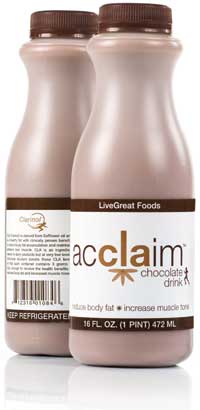Doing Dairy
Originally Published <a data-cke-saved-href="/sites/beta.nutritionaloutlook.com/files/articlelist.php?issueid=61" href="/sites/beta.nutritionaloutlook.com/files/articlelist.php?issueid=61" "="">NO June 2010
Originally Published NO June 2010

It was just a few decades ago that conjugated linoleic acid (CLA) was unheard of. But fast-forward to 2010, and CLA is no stranger.
The fatty acid derived from grass-fed livestock has primarily made its name as a weight-management supplement, with studies showing its ability to burn fat while increasing lean mass. Now, thanks to recent FDA-affirmed generally recognized as safe (GRAS) status, CLA is ready to aid weight in the form of functional foods.
Lipid Nutrition (Channahon, IL), the producer of Clarinol brand CLA, was largely responsible for getting CLA its GRAS status in 2008, and now they're helping to put CLA on the food map. This year alone, Lipid Nutrition's Clarinol CLA has brought about some notable firsts to CLA functional foods.
In February, Old Home Foods (New Brighton, MN) premiered its Safflower Power Yogurt with Clarinol CLA, making it the first-ever CLA-fortified yogurt in the United States. Available in eight different flavors, each 6-oz cup provides 1.5 g of CLA.
Shortly after the release of Safflower Power came Acclaim Chocolate Milk by LiveGreat Foods (Madison, WI). Also featuring Clarinol, Acclaim is the first fluid milk to incorporate CLA, at 3 g per each 16-oz bottle.
CLA naturally reaches our diets from grass-fed livestock meats and dairy products-so why formulate CLA back into dairy? Because today's factory farming methods have greatly reduced the amount of CLA-rich products the public is exposed to.
These days, typical dairy products like milk, cheese, and yogurt actually run low in CLA, says Patrick Luchsinger, North American marketing manager for Lipid Nutrition.
"These sources contain such low levels of CLA that the consumer cannot achieve the beneficial levels of CLA for weight management," says Luchsinger. "These levels can be boosted by adding Clarinol CLA."
To understand the benefit of fortifying with CLA for the weight-management category, let's take a look at the science.
Luchsinger notes that in more than 30 published human studies, CLA supplementation improved the ratio of lean body mass to fat mass, while also increasing lean body mass.

The thought of an ingredient being able to reduce fat mass and increase lean mass is impressive-almost too good to be true-but the resulting body changes have proven modest, yet consistent.
In 2007, the British Journal of Nutrition published a double-blind, placebo-controlled study in which 118 overweight but otherwise healthy subjects (body mass indexes from 28 to 32) supplemented with 3.4 g of CLA or placebo, daily, for six months. Compared to placebo, body fat mass decreased in the CLA group by an average of 0.9% and 3.4% when measured at three and six months, respectively. Most fat loss occurred in the legs. In addition, average lean body mass increased over the six-month trial by more than one pound in the CLA group.
Another study, published in The Journal of Nutrition in the same year, tested the effects of CLA and placebo (nonfortified safflower oil) on 48 overweight but otherwise healthy subjects. After 12 weeks, researchers concluded that a 6.4-g daily dosage of CLA resulted in an average increase of 1.4 lb of lean mass over placebo.
Such results are modest, but they lean in favor of improved body composition for subjects whose results were not influenced by diet and exercise.
"CLA is more of an aid to improve body composition and manage weight than a weight-loss aid," says Corey Scott, PhD, nutrition manager for Lipid Nutrition. "For consumers looking to maintain their weight and reshape their bodies, CLA is very effective. In addition, adding lean mass helps to burn more calories, and the amount of fat mass in the body is linked to several chronic diseases; so, not only from a cosmetic standpoint, losing fat mass and gaining lean mass, even if modestly, can be beneficial for energy metabolism and overall health."
Consistent science and safety records (CLA has been shown safe in trials as long as two years) and new GRAS status has the United States primed for a bigger CLA market.
Overseas, that momentum is growing, too. In May, the European Food Safety Authority (EFSA; Parma, Italy) produced positive safety reports for consumption of Clarinol and Tonalin, a brand of CLA supplied by Cognis Nutrition & Health (Cincinnati). Tonalin CLA is already GRAS-approved in the United States and authorized as a Novel Food in China. For both CLA brands, EFSA considers consumption for as long as six months to be safe. EFSA's safety confirmation brings Clarinol and Tonalin one step closer to Novel Food status in Europe.
The gradual increase in CLA studies over the past several years, along with improving recognition from government agencies around the globe, has CLA players optimistic about the ingredient's future. In fact, Luchsinger likens CLA's direction to the path taken by the omega-3 market.
"Over 10 years ago, the level of consumer awareness of omega-3 fatty acids was not very high," says Luchsinger, "but with the continual publication of clinical studies demonstrating its benefits and increased use in functional-food applications, the consumer awareness of omega-3 fatty acids increased dramatically. I think there's a good chance that CLA awareness will mirror that of omega-3 fatty acids."
Clarinol CLA is currently available in liquid, powder, and emulsion form in the United States. Its GRAS status allows for its use in food categories including fluid milks, yogurts, nutritional bars, milk-based meal replacement shakes, soy beverages, juices, and sport food.
The impact of GLP-1 on supplements, functional foods, and retail: a webinar from CRN
January 29th 2025The recent CRN webinar discussed GLP-1 medications' impact on supplements, functional foods, and retail, covering consumer trends, global market insights, retailer strategies, industry implications, and future opportunities for innovation.





